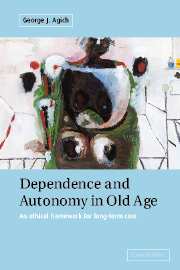3 - Long-term care: myth and reality
Published online by Cambridge University Press: 31 October 2009
Summary
Discussion of autonomy in long-term care is complicated because assumptions about the nature of caregiving relationships provide inaccurate, inadequate, and misleading models for long-term care. Long-term care is often assumed to be institutional care in which elders live without familial or other social supports. The ethical problem is seen in this institutional context as involving conflicts over basic rights as the long-term care total institution (Goffman 1960, 1961) strips elders of self-control and self-respect. The empirical evidence, however, presents a more complicated picture that seems to belie the values of independence and the right of noninterference that are at the core of the bioethical response.
Survey data demonstrate that over 70 percent of home care is delivered by family and friends, not paid providers (Rabin and Stockton 1987: 151), a percentage that parallels the 67 percent of older noninstitutionalized persons who lived in a family setting in 1998 (Administration on Aging 2000). Families contributed financially to the institutional care of older relatives and 13 percent of older persons (7 percent of men and 17 percent of women) were living with children, siblings, or relatives other than a spouse (Administration on Aging 2000). Instead of the picture of isolated, vulnerable old people needing the protection from an impersonal institution, a picture emerges in which the majority of dependent old people maintain various kinds of integrated lives, often in proximity to family and friends.
- Type
- Chapter
- Information
- Dependence and Autonomy in Old AgeAn Ethical Framework for Long-term Care, pp. 51 - 82Publisher: Cambridge University PressPrint publication year: 2003



